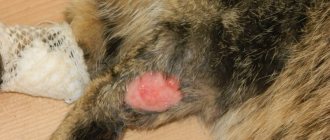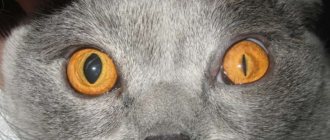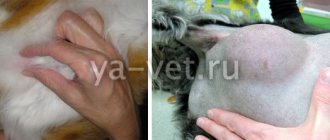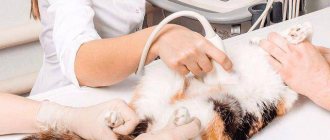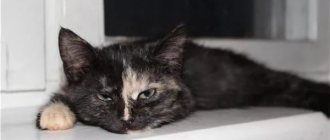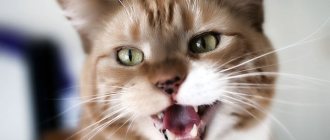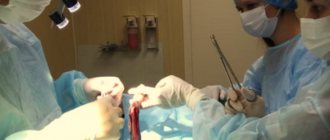If a cat scratches its neck, this condition should not be ignored, as it may indicate serious dermatological or other diseases. The appearance of bald spots behind the ears of a kitten or small crusts can also signal an allergic reaction, which does not require special treatment, it is enough to simply eliminate the irritant. When irritation is accompanied by other unpleasant symptoms or the wound bleeds, you should immediately contact a veterinarian, since delaying treatment will lead to infection and other complications dangerous to the cat’s health.
A little theory
The wound in this case is a violation of the integrity of the skin layer, affecting the underlying tissue . It can be superficial (essentially a serious scratch) or deep, affecting even the muscle layer and large vessels. In pets, such pathologies are most often the result of traumatic exposure. They occur during fights, attacks by other animals, after collisions with cyclists or cars, and also include surgical injuries that have to be inflicted on the animal during surgery. In short, there are many reasons. But in this case, it is much more important to us what happens to the wound in the future.
Its healing can occur in two types , first described by the luminary of Russian medicine, N.I. Pirogov. He distinguished between healing by primary and secondary intention. With primary intention, wounds heal only after surgery: their edges are smooth, regenerative processes start immediately. Considering that during any operation the rules of asepsis and antiseptics are strictly observed, and therefore the effect of pathogenic and conditionally pathogenic microflora is completely excluded. This happens in several stages:
- Granulation. To protect itself from the penetration of microflora and debris into the wound cavity, the body begins to “darn” the wound with granulation. Fibroblasts and endothelial cells participate in the process, and new blood vessels grow from the latter.
- Increasing the epidermal layer. Epithelial cells along the edges of the wound channel gradually begin to “slide” onto the upper surface of the granulation, forming a new layer of skin epidermis.
- Myofibroblasts also play an important role in the healing process. It is from these cells that muscle fibers subsequently develop. They play the role of a kind of “ties”, literally tightening the edges of the former wound channel.
In principle, wound healing by secondary intention proceeds similarly, but in this case pyogenic microflora interferes with the process: complete granulation of the wound canal will not occur until all dead tissue and microbes are removed from the wound along with pus and other secretions. And it is with this process that difficulties may arise...
Examine the cat after a fight
Bites can most often be found on males. The bites are the result of their struggle for the right to participate in mating and for territory. However, sometimes castrated cats and even females fight and get injured. Most often, in a fight, it gets to the front paws and head (if the opponents meet “face to face”), or the tail and back of the body if one of the warriors takes flight. However, if cats struggle while rolling on the ground, any part of the body can be injured. Sometimes a cat may develop an abscess on its neck. This happens due to the fact that the cat perched on her during mating clings too tightly to the “lady’s” skin.
Cats typically bite with two long fangs (one each on the lower and upper jaws on either side of the mouth), which pierce the skin and underlying flesh. These teeth are very sharp and thin, so that the wounds they cause have a small area, bleed little and soon close on their own. In addition, they are not easy to see under the fur. The blood trail disappears as the cat retreats and (literally) licks its wounds. So if the cat does not have obvious signs of a fight - a torn ear, for example, you may not even guess that he took part in it. However, after a fight, the cat remains agitated for a long time, and your attempts to calm him down may end in him buying or scratching you.
Within 1-2 days after the fight, you may notice one of the following features:
The cat is limping on one leg or is reluctant to move any part of the body: neck, tail.
Winces, meows, or becomes aggressive when you try to touch any part of his body.
Refuses food and wants one thing: rest.
These signs indicate the development of an abscess in the bitten area. Long fangs carry bacteria deep into the body from their surface, from the skin of the bitten person and hairs from his skin. The wound is very small, so its edges close and it begins to heal, but the bacteria that get into it multiply and release toxins. They cause inflammation of adjacent tissues and are carried by the blood throughout the body. In severe cases, the toxins can even affect the brain, leading to loss of appetite and lethargy accompanied by a rise in temperature.
To make sure that this was due to a bite, carefully examine the suspected location. Somewhere there should be two tiny wounds located at a distance of 1.25-2.5 cm from each other. On the paw or tail, the wounds will most likely be located opposite each other. You can feel them as two small rough scars; when you part the fur, you will see two healed wounds with dried blood.
As a result of the fierce battle between bacteria and white blood cells, pus (consisting of living and dead bacteria and blood cells) is released and an abscess is formed. By the time the abscess matures, the inflammation and pain have subsided, although toxins continue to be absorbed by the body, so the cat may still have poor appetite and general lethargy. But these signs are not always present. Sometimes the abscess can be felt. It is a soft, mobile subcutaneous formation over time; if left undisturbed, it breaks through to the surface as the skin erodes. It often happens that for the owner, this discharge of a mixture of blood and pus is the first evidence that something has passed. Sometimes the abscess grows significantly and damages a large area of skin, which then peels off.
Whatever stage of development the wound you find is at, contact your veterinarian immediately. For treatment, we can recommend hot baths (fomentations), surgical excision of the abscess and/or the use of antibiotics (injections, tablets, ointments) - depending on the degree of development of the process. If the abscess has been opened or opened itself and then cleaned out, one task remains: the wound must heal. Healing must occur from the depths of the wound, so the skin should heal last. If this does not happen, the infection remains inside and a new abscess develops as a result. To prevent this development of events, peroxide is used at the initial stage, and then hot baths are used and antibiotic ointments are rubbed into the wound.
Bacteria that enter a wound can spread throughout the body; bites in the sternum area can cause suppuration in the chest. Of course, an abscess may appear not due to a bite, but, for example, due to infection of the tooth socket and the formation of pus, which then has to be pumped out.
See also: why do cats sleep at their owners’ feet?
Similar articles:
What is a weeping wound, the reasons for its occurrence
This is a wound whose surface is not contracted by granulations and does not heal. It literally oozes ichor or necrotic exudate. The color and smell of the exudate resembles rotting meat slop. It is necessary to distinguish a weeping wound from an ulcer: in the first case, a skin defect occurs as a result of mechanical action, in the second it is only a consequence of some severe metabolic disorders or hormonal metabolism in the body (a good example is ulcers due to diabetes or uremia).
Treatment
In cats, treatment can be quite lengthy, the prognosis depends on the cause of the disease, for example, the neuropathic form is less treatable than others. In any case, a preliminary consultation with a specialist is required, a series of examinations that will help to describe the treatment regimen as accurately as possible.
The principles of therapy for dermatosis in cats are similar to therapy for humans, the same means are used. If it worsens, the veterinarian will prescribe injections; to treat the affected areas, the hair around them should be carefully trimmed.
The following drugs and groups of drugs are used for therapy:
For dry eczema, moisturizers are used to help soften the affected area and prevent peeling and cracking. For cats, it is recommended to use Vaseline, baby creams without fragrances and fragrances. To disinfect affected skin, antiseptics should be used. They are applied before using basic products, most often potassium alum, tannin solution, formaldehyde. For weeping eczema, dust, bismuth salts, and rivanol will be effective. To have a drying effect, the usual brilliant green and iodine are prescribed; for disinsection of the affected area, ethyl alcohol and hydrogen peroxide are prescribed. External treatment often requires the use of hormonal ointments. Steroids are prescribed for complications; they not only speed up recovery, but also alleviate the general condition of the pet
But hormonal medications for cats should be used with great caution to prevent side effects. Among the most effective remedies are Triderm, Advantan, and hydrocortisone ointments. Non-hormonal creams are used for topical treatment after taking corticosteroids
The drugs are taken for a month until remission occurs. Among the most effective are Radevit, Pikhtoin, Saphroderm and others. Antibiotics are used as part of antimycotic and antibacterial therapy for cats, but only a veterinarian can prescribe a specific drug after examination. The most suitable powders for pets are Tsamax, Ranosan, Anandin, tetracycline ointment, Vedinol and others.
To speed up a cat’s recovery, vitamin complexes and medications are often prescribed to strengthen the immune system and improve skin regeneration. Weeping eczema is the most difficult to treat, requiring additional action. Usually, doctors, along with traditional therapeutic methods, prescribe a number of folk remedies that help cope with the disease and significantly alleviate the animal’s condition.
Traditional methods of treatment
Eczema in cats can be treated using traditional methods, but only after consultation with a veterinarian. There are many methods, but all of them are external and are recommended as an addition to the main therapy.
The following recipes are recommended for pets:
- Decoctions from willow bark. Making such a remedy is very simple, you need to brew two tablespoons of bark in a glass of water (about 10 minutes), then cool the solution and wash the wounds with it several times a day.
- Tinctures of dandelion and burdock roots. To do this, you can use dried or fresh ingredients; they are infused in 0.5 liters. vodka in an amount of 2 full tablespoons of each component. Preparation time: 10 days; infuse in a dark place. The resulting tincture is applied to areas of skin damage in the evening and in the morning, treatment time is a week. The tincture relieves itching, relieves discomfort and other symptoms.
- An infusion of fresh currant leaves is well suited for washing wounds. A handful of leaves should be brewed in two glasses of boiling water, left for an hour, then cooled and used for procedures.
- For dry eczema, a compress based on regular sunflower oil and celery works well. The crushed root must be mixed with oil (only unrefined oil is suitable), after which the resulting product is used for compresses. This remedy removes itching, swelling, and alleviates the pet’s condition. Compresses can also be made at the stage when bubbles appear.
- Ointment based on celandine. Only a fresh plant is used for preparation; the ointment can be stored in the refrigerator for about a year. For preparation, a gruel of crushed celandine and petroleum jelly is used in a ratio of 1:4. The product should be applied 2-3 times a day, treating the affected areas.
Eczema is a disease caused by poor nutrition, emotional discomfort, and poor pet hygiene.
It is very important to immediately contact a veterinarian at the first signs of illness, as complications will be much more difficult to get rid of.
Diagnostics
In general, diagnosing a weeping wound does not cause any difficulties; everything is quite obvious, based on the visual signs of the pathological process. It is much more important to find out which microbe caused the inflammatory process. To answer this question, it is necessary to take a sample of pathological material from the wound and inoculate it on a nutrient medium.
In addition, it may be necessary to take blood and urine tests when there is a suspicion of the endogenous origin of a weeping wound (that is, to identify hormonal and other disorders).
Symptoms and treatment of feline eczema
Regardless of the reasons for the appearance of inflammation in the upper layer of the epidermis, the signs of the disease are the same.
- The very first symptom is redness. This occurs as a result of the fact that it is in this area of the dermis that there is lymph and blood circulation.
- Itching. The place where the inflammation began is itchy, and the cat persistently tries to scratch it. Toxins accumulate in tissues, nerve endings are irritated - this is why itching occurs.
- If you touch a red area of skin, you can record an increased temperature in this spot. Sensitivity also increases.
- As a result of intoxication, bubbles appear. In the dry form, the blisters burst and the skin peels off; usually this form is characteristic of a chronic course. In the wet form, liquid leaks from the ruptured blisters, and the wound is constantly wet. This occurs due to infection of the inflamed area. Scratched wounds receive pyogenic microflora, which provokes wet, festering wounds.
Treatment
The diagnosis must be made by a specialist and treatment prescribed.
Primary measures:
- Isolate the cat from drafts and cold places.
- Treat against fleas, worms and free her from the collar (if she is wearing) during treatment.
- If eczema is a secondary disease against the background of inflammation of internal organs (this is also determined by a veterinarian), the underlying disease must be treated.
- Analyze your pet’s diet, eliminate potential allergens, and introduce vitamins.
- It is better to shave the affected area, this will avoid infection, and also treat it with alcohol or Chlorhexidine.
Treatment with drugs:
- To reduce a cat's irritability, bromine is recommended.
- To normalize skin sensitivity, sodium thiosulfate is needed.
- Antihistamines: Suprastin, Diphenhydramine.
- Methylprednisolone, Prednisolone and Dexamethasone are effective in treating eczema.
- Furosemide is needed as a diuretic to rid the body of toxins.
- Weeping eczema in cats requires treatment with Chlorhexidine, peroxide or Miramistin.
- To provide an astringent effect, a solution of tannin or silver nitrate is required.
- Zinc ointment is suitable for drying pappules.
- If a cat has dry eczema, Vishnevsky ointment helps.
Folk remedies are also appropriate in the treatment of eczema.
- Treatment of the affected area with chamomile decoction, calendula solution, oak decoction (has an astringent effect) is effective.
- St. John's wort oil removes dry eczema and accelerates cell regeneration.
- Aloe juice has a wound healing effect.
Disease prognosis
Eczema can occur in acute and chronic forms. Acute is typical for young cats, chronic - for cats over 6 years old, as well as for weakened pets.
The acute form can last about a month, and intensive treatment is effective in combating it.
Therapeutic techniques
How to treat a weeping wound on a cat? In mild cases, they resort to “open”, “dry” wound treatment. This does not mean that the damage is left open to environmental factors. Its purpose is to create the most favorable conditions for wound healing by the body itself. Sometimes a simple bandage is quite enough for healing by secondary intention, but for this to happen several factors must coincide:
- The regeneration process is progressing well.
- It is important to prevent the formation of large scars, which can impair the functionality of the damaged organ or reduce the breeding value of the animal.
- The patient tolerates the dressing without tearing it off every two minutes.
Causes
The following factors contribute to the occurrence of eczema:
- Traumatic.
- Neuropathic.
- Reflex.
- Interior.
Traumatic eczema
It occurs as a result of damage from accessories rubbing the skin, arthropod bites, frostbite, burns, and trauma from the claws of the cats themselves. The disease occurs in a weeping form and quickly stops after its cause is eliminated.
Neuropathic eczema
It is the result of stress or a congenital anomaly. This type of eczema is characterized by symmetrical bilateral skin lesions. It occurs in dry and wet form. The disease is characterized by remissions and exacerbations under the influence of stress factors.
Reflex eczema
It is a hypersensitive response to a stimulus. The reaction occurs under the influence of the following allergens:
- Arthropod saliva.
- Household items.
- Food allergens.
- Atopic dermatitis.
- Dust.
- Accessories.
Internal factors
Internal causes of eczema are associated with organ pathologies, irrational feeding, and hormonal perversions. Signs of the disease disappear when the factor that caused them is eliminated.
About the need for surgical intervention
If an unpleasant odor emanates from the wound and the animal’s condition begins to give rise to concern, it is imperative to take the pet to the veterinarian. The specialist will be able to treat the wound canal; he will completely remove dead and destroyed tissue. In short, after surgical treatment, conditions will be created for healing by primary intention.
To eliminate the possibility of re-development of pathogenic microflora, the animal is prescribed a course of broad-spectrum antibiotics (of course, it is advisable to grow a culture of the pathogen before this). It is possible (provided that the pathogen reacts to them) to prescribe sulfonamide drugs to the pet. Sometimes comprehensive treatment can be more effective.
In milder cases, tampons soaked in syntomycin liniment or Vishnevsky's balsamic liniment are applied to the wound itself . These agents draw off pus or necrotic exudate. If for some reason applying ointment is impossible, you can use a saturated solution of ordinary table salt or even sugar for this. The latter is also a strong preservative and in high concentrations prevents the growth of bacteria.
It is also advisable to treat the surface of a weeping wound daily with a 3% solution of hydrogen peroxide. This must be done very carefully, soaking a cotton swab in the medicine. It is important to try not to irritate or injure the cat again. It is important to emphasize that in any case it is necessary to prevent licking and scratching of the wound, especially when it is on the face. For this purpose, a surgical (Elizabethan) collar is placed on the pet’s neck.
Necessary diagnostic measures
The manifestation of parallel symptoms indicates the need to show the animal to a specialist.
When a cat scratches its neck until it bleeds and other unpleasant symptoms are observed, you should contact a veterinary clinic. The specialist will examine the pet’s damaged skin and assess the animal’s general condition. Simple disorders such as allergies can be determined by visual inspection and determination of the cat’s diet or its possible contact with irritants. If it was not possible to determine the causes of wounds on the neck in this way, then additional diagnostics are carried out, which include the following manipulations:
- laboratory blood test;
- general analysis and bacterial culture of urine;
- allergic reaction test;
- scraping to identify pathogenic microorganisms.
Prevention of skin diseases in cats
Prevention includes the following measures:
- timely treatment of the skin from cutaneous and subcutaneous parasites;
- annual vaccination;
- compliance with hygiene standards;
- proper nutrition;
- regular cleaning of carpets;
- washing floors and toys;
- wearing flea and tick collars;
- inspection of the animal after a walk.
Once a skin disease is detected, the animal must be under constant supervision. It is necessary to give your pet medications in a timely manner, carry out the necessary treatment, and monitor his well-being.
Video
